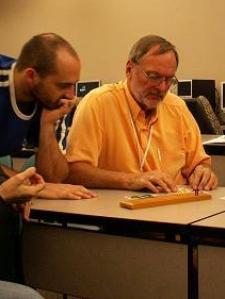
Alexus V.
asked • 05/25/17How do you tell the difference between translation, rotation, reflection, and dilation?
I need help for my math test.
More
2 Answers By Expert Tutors
Daly J. answered • 05/25/17
Tutor
3.5
(2)
Experienced, Enthusiastic Tutor and Certified Math Teacher
Hey, Alexus. A translation simply moves the graph, or pre-image, without changing the size or spinning the image. So a rectangle that is 2 units wide and 4 units tall will stay that size, and will still "stand up straight" after being translated.
A reflection flips the pre-image across some line.
A rotation spins the pre-image around a point.
A dilation either expands or shrinks the pre-image. Find the difference between the coordinates of the center of dilation and the coordinates of each corner of the pre-image. Then multiply each of these differences by the scale factor.
example: to dilate the rectangle with corners at points (0,0), (1,0), (1,-2), and (0,-2) by a scale factor of 2, with a center of dilation (2,-2):
points:
(0,0) 2-0=2 and 2x2=4, 2-4=-2; -2-0=-2 and -2x2=-4, -2 - (-4)=2
SO the point (0,0) is dilated to the point (-2,2)
(1,0) is dilated to (0,2);
(1,-2) is dilated to (0,-2);
(0,-2) is dilated to (-2,-2).
A reflection flips the pre-image across some line.
A rotation spins the pre-image around a point.
A dilation either expands or shrinks the pre-image. Find the difference between the coordinates of the center of dilation and the coordinates of each corner of the pre-image. Then multiply each of these differences by the scale factor.
example: to dilate the rectangle with corners at points (0,0), (1,0), (1,-2), and (0,-2) by a scale factor of 2, with a center of dilation (2,-2):
points:
(0,0) 2-0=2 and 2x2=4, 2-4=-2; -2-0=-2 and -2x2=-4, -2 - (-4)=2
SO the point (0,0) is dilated to the point (-2,2)
(1,0) is dilated to (0,2);
(1,-2) is dilated to (0,-2);
(0,-2) is dilated to (-2,-2).
Translation: The shape or object will move left, right, up, or down. Also, you could have a combination like up and right.
Rotation: The shape or object will turn. This is usually turning some degree clockwise or counterclockwise.
Reflection: The shape or object flips across a line or point
Dilation: The shape or object gets smaller or bigger by a scale factor.
I hope this helps.
Still looking for help? Get the right answer, fast.
Ask a question for free
Get a free answer to a quick problem.
Most questions answered within 4 hours.
OR
Find an Online Tutor Now
Choose an expert and meet online. No packages or subscriptions, pay only for the time you need.







Kenneth S.
05/25/17